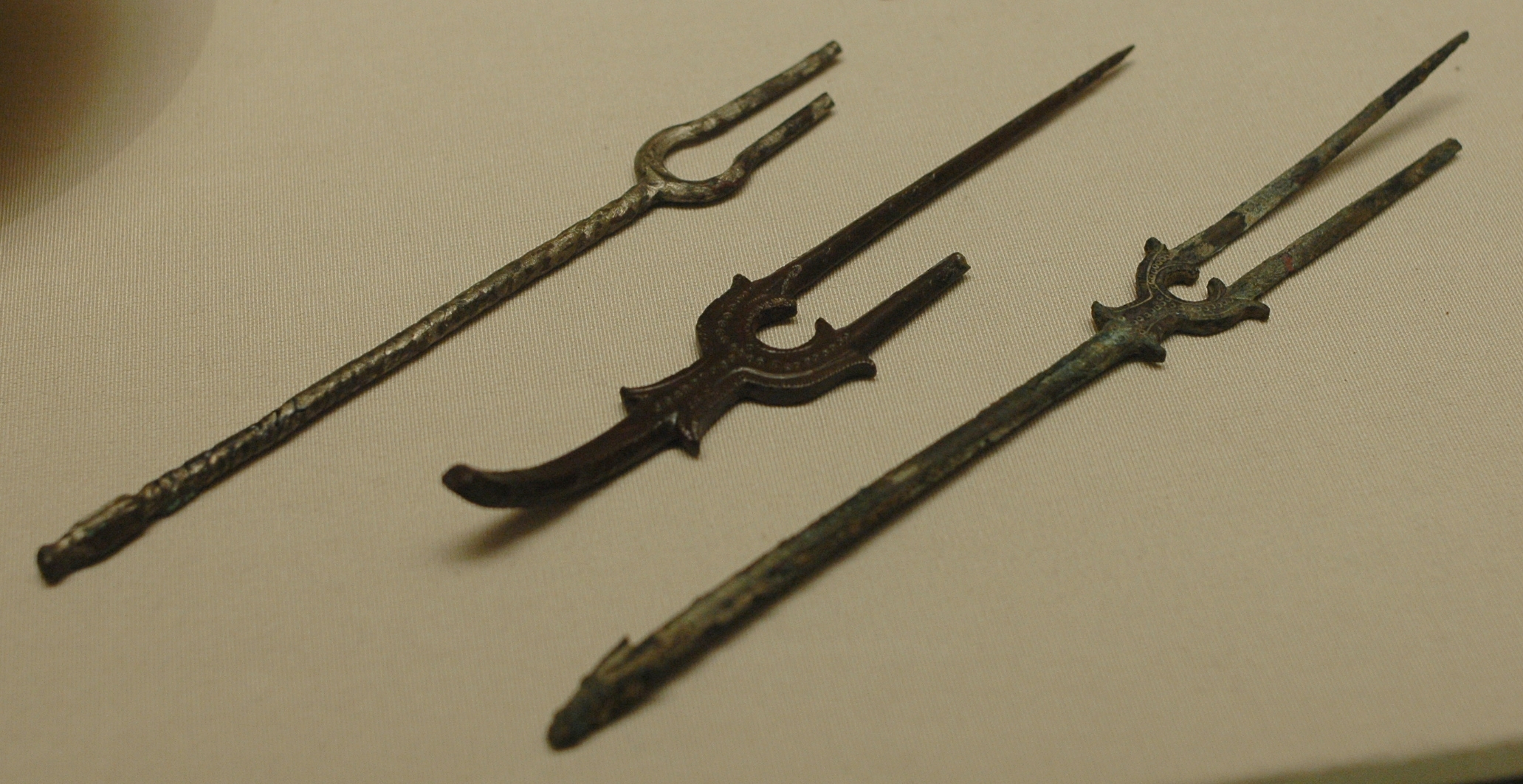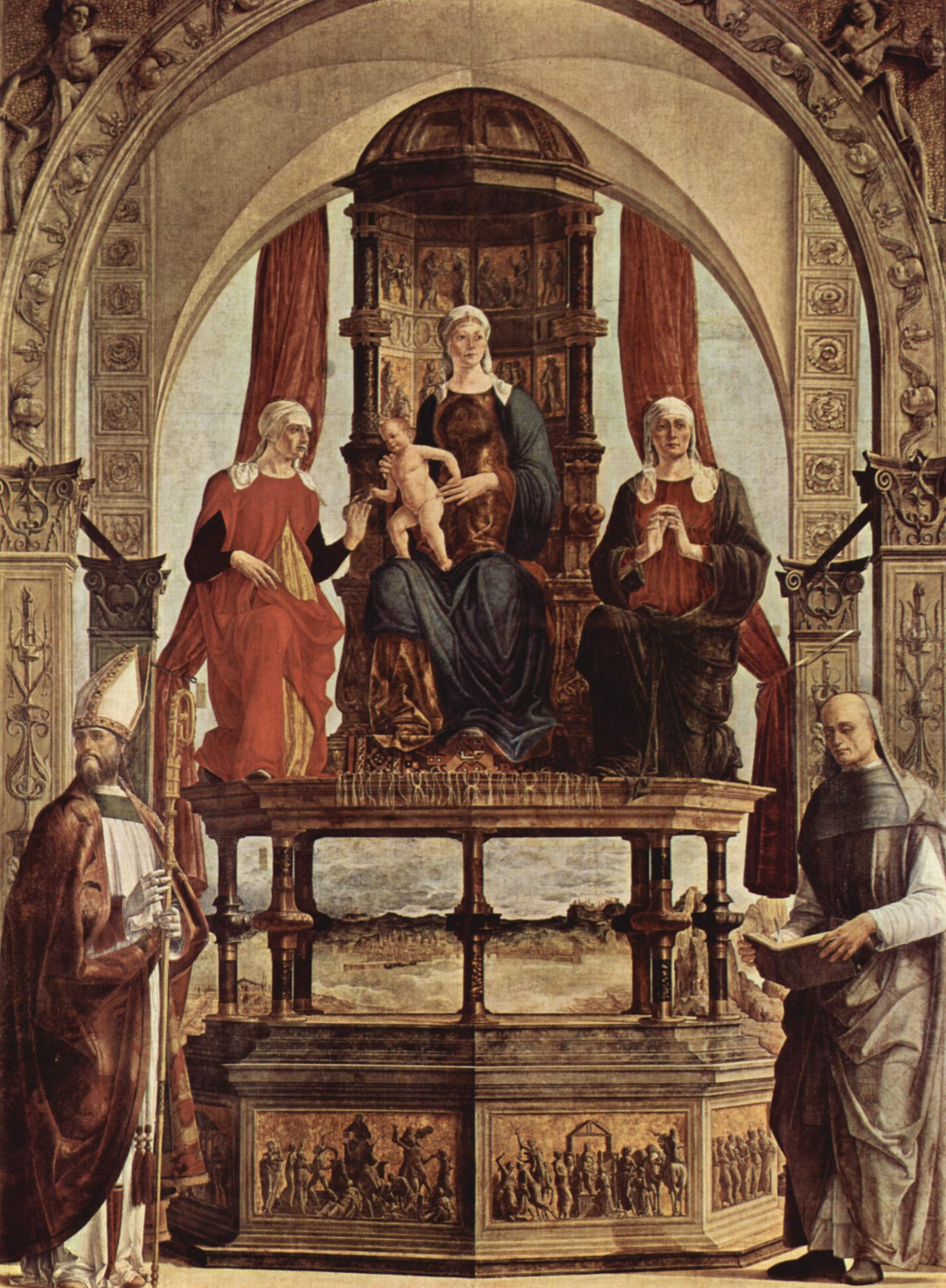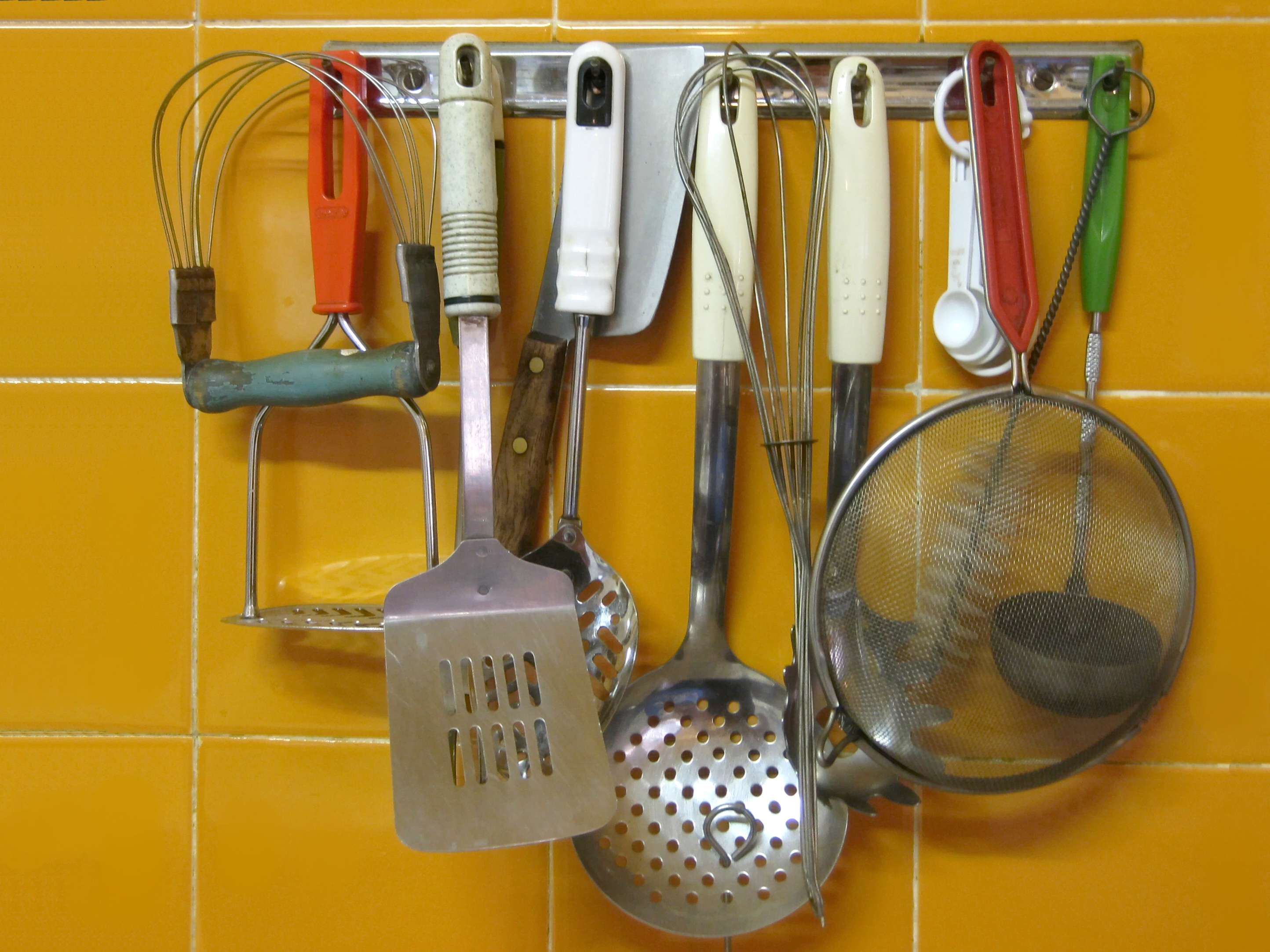|
Fork
In cutlery or kitchenware, a fork (from la, furca 'pitchfork') is a utensil, now usually made of metal, whose long handle terminates in a head that branches into several narrow and often slightly curved tines with which one can spear foods either to hold them to cut with a knife or to lift them to the mouth. History Bone forks have been found in archaeological sites of the Bronze Age Qijia culture (2400–1900 BC), the Shang dynasty (c. 1600–c. 1050 BC), as well as later Chinese dynasties.Needham (2000). ''Science and Civilisation in China. Volume 6: Biology and biological technology. Part V: Fermentations and food science.'' Cambridge University Press. Pages 105–110. A stone carving from an Eastern Han tomb (in Ta-kua-liang, Suide County, Shaanxi) depicts three hanging two-pronged forks in a dining scene. Similar forks have also been depicted on top of a stove in a scene at another Eastern Han tomb (in Suide County, Shaanxi). In Ancient Egypt, large forks were used as ... [...More Info...] [...Related Items...] OR: [Wikipedia] [Google] [Baidu] |
Forks Susa Louvre MAO421-422-431
In cutlery or kitchenware, a fork (from la, furca 'pitchfork') is a utensil, now usually made of metal, whose long handle terminates in a head that branches into several narrow and often slightly curved tines with which one can spear foods either to hold them to cut with a knife or to lift them to the mouth. History Bone forks have been found in archaeological sites of the Bronze Age Qijia culture (2400–1900 BC), the Shang dynasty (c. 1600–c. 1050 BC), as well as later Chinese dynasties.Needham (2000). ''Science and Civilisation in China. Volume 6: Biology and biological technology. Part V: Fermentations and food science.'' Cambridge University Press. Pages 105–110. A stone carving from an Eastern Han tomb (in Ta-kua-liang, Suide County, Shaanxi) depicts three hanging two-pronged forks in a dining scene. Similar forks have also been depicted on top of a stove in a scene at another Eastern Han tomb (in Suide County, Shaanxi). In Ancient Egypt, large forks were used as ... [...More Info...] [...Related Items...] OR: [Wikipedia] [Google] [Baidu] |
Peter Damian
Peter Damian ( la, Petrus Damianus; it, Pietro or '; – 21 or 22 February 1072 or 1073) was a reforming Benedictine monk and cardinal in the circle of Pope Leo IX. Dante placed him in one of the highest circles of '' Paradiso'' as a great predecessor of Francis of Assisi and he was declared a Doctor of the Church on 27 September 1828. His feast day is 21 February. Early life Peter was born in Ravenna around 1007, the youngest of a large but poor noble family. Orphaned early, he was at first adopted by an elder brother, who ill-treated and under-fed him while employing him as a swineherd. After some years, another brother, Damianus, who was archpriest at Ravenna, had pity on him and took him away to be educated. Adding his brother's name to his own, Peter made such rapid progress in his studies of theology and canon law, first at Ravenna, then at Faenza, and finally at the University of Parma, that, around the age of 25, he was already a famous teacher at Parma a ... [...More Info...] [...Related Items...] OR: [Wikipedia] [Google] [Baidu] |
Kitchenware
:'' For a record label, see Kitchenware Records'' Kitchenware are the tools, utensils, appliances, dishes, and cookware used in food preparation, or the serving of food. Kitchenware can also be used in order to hold or store food before or after preparation. Types Kitchenware encompasses a wide range of tools. Some of the most common items of kitchenware are: See also * Batterie de cuisine * Cookware and bakeware * Gastronorm, a European size standard for kitchenware * List of cooking vessels * List of eating utensils * List of food preparation utensils * List of glassware * List of Japanese cooking utensils * List of serving utensils * List of types of spoons * NSF International, formerly "National Sanitation Foundation" * Tableware Tableware is any dish or dishware used for setting a table, serving food, and dining. It includes cutlery, List of glassware, glassware, serving dishes, and other items for practical as well as decorative purposes. The quality, nature ... [...More Info...] [...Related Items...] OR: [Wikipedia] [Google] [Baidu] |
Pitchfork
A pitchfork (also a hay fork) is an agricultural tool with a long handle and two to five tines used to lift and pitch or throw loose material, such as hay, straw, manure, or leaves. The term is also applied colloquially, but inaccurately, to the garden fork. While similar in appearance, the garden fork is shorter and stockier than the pitchfork, with three or four thicker tines intended for turning or loosening the soil of gardens. Alternative terms In some parts of England, a pitchfork is known as a ''prong''. In parts of Ireland, the term ''sprong'' is used to refer specifically to a four-pronged pitchfork. Description The typical pitchfork consists of a wooden shaft bearing two to five slightly curved metal tines fixed to one end of a handle. These are typically made of steel, wrought iron, or some other alloy, though historically wood or bamboo were used. Unlike a garden fork, a pitchfork lacks a grab at the end of its handle. Pitchforks with few tines set far apart a ... [...More Info...] [...Related Items...] OR: [Wikipedia] [Google] [Baidu] |
Theodora Doukaina Selvo
Theodora Doukaina ( el, Θεοδώρα Δούκαινα) (before 1059– after 1075) was a Byzantine princess and dogaressa. Life Theodora Doukaina was the second daughter of Byzantine emperor Constantine X Dukas by his unknown first wife. After 1071 she became the wife of Domenico Selvo, Doge of Venice, who received the title of ''protoproedros'' at the occasion. As she is mentioned as alive in the work of Michael Psellos (1075), it is assumed she died after this last date. It is not known if she had children, and she is not mentioned otherwise. Confusion with Maria Argyropoulaina Peter Damian, the Cardinal Bishop of Ostia, wrote a chapter entitled "De Veneti ducis uxore quae prius nimium delicata, demum toto corpore computruit" ("Of the Venetian Doge's wife, whose body, after her excessive delicacy, entirely rotted away.") about an unnamed Byzantine princess whose manners he considered scandalously lavish and which brought to her a horrible death as a divine punishment. This ... [...More Info...] [...Related Items...] OR: [Wikipedia] [Google] [Baidu] |
Maria Argyropoulina
Maria Argyra (also Argyre or Argyropoulina) ( el, Μαρία Ἀργυρή or Ἀργυροπουλίνα; died 1007), of the Argyros family, was the granddaughter of the Byzantine emperor Romanos II, niece of the emperors Basil II and Constantine VIII, and sister to the Byzantine emperor Romanos III Argyros. In the ''Chronicon Venetum'' by John the Deacon, it is mentioned that Maria was the daughter of a noble patrician, called Argyropoulos, who was a descendant of the imperial family. This information is confirmed by the chronicle of Andrea Dandolo, who says that she was the niece of the emperor Basil II. In 1004 Maria was married to Giovanni Orseolo, the son of the Doge of Venice Pietro II Orseolo, in the Iconomium palace in Constantinople with full imperial pageantry – the couple was crowned with golden diadems by Basil II. Maria brought to her husband great dowry, including a palace in the imperial capital, where they lived after the wedding. Basil also honored Maria's h ... [...More Info...] [...Related Items...] OR: [Wikipedia] [Google] [Baidu] |
Giovanni Orseolo
Giovanni Orseolo (981-1006/7) was the first Venetian to hold power in Dalmatia, holding the title of ''Dux Dalmatiae''. History Giovanni's father Pietro II Orseolo was the Doge of Venice, and his mother was Maria Candiano. In 1000 he was sent to Constantinople to work out the details of a plan his father and the Byzantine Emperor Basil II had been working on. Under this agreement the Venetians would conquer Dalmatia and then hold it as a protectorate under Byzantine suzerainty.(Norwich, John Julius. "Byzantium: The Apogee" (Alfred A. Knopf: New York, 1992) p. 257). While in Constantinople he was given a standard to use in his upcoming invasion of Dalmatia by the Bishop of Olivolo. He was successful in establishing Venetian power on the Dalmatian coast. In 1004 Giovanni married Maria Argyre, who was probably niece of Basil II and relative to the latter's second cousin and future emperor Romanos III Argyros. By this time Giovanni had been advanced to the rank of co-doge of V ... [...More Info...] [...Related Items...] OR: [Wikipedia] [Google] [Baidu] |
Doge Of Venice
The Doge of Venice ( ; vec, Doxe de Venexia ; it, Doge di Venezia ; all derived from Latin ', "military leader"), sometimes translated as Duke (compare the Italian '), was the chief magistrate and leader of the Republic of Venice between 726 and 1797. Doges of Venice were elected for life by the Venetian nobility. The ''doge'' was neither a duke in the modern sense, nor the equivalent of a nobility, hereditary duke. The title "doge" was the title of the senior-most elected official of Republic of Venice, Venice and Republic of Genoa, Genoa; both cities were republics and elected doges. A doge was referred to variously by the titles "My Lord the Doge" ('), "Most Serene Prince" ('), and "Serene Highness, His Serenity" ('). History of the title Byzantine era The office of doge goes back to 697. The first historical Venetian doge, Orso Ipato, Ursus, led a revolt against the Byzantine Empire in 726, but was soon recognised as the () and (a honorific title derived from the Greek w ... [...More Info...] [...Related Items...] OR: [Wikipedia] [Google] [Baidu] |
Pietro II Orseolo
Pietro II Orseolo (961−1009) was the Doge of Venice from 991 to 1009. He began the period of eastern expansion of Venice that lasted for the better part of 500 years. He secured his influence in the Dalmatian Romanized settlements from the Croats and Narentines, freed Venetia from a 50-year-old taxation to the latter, and started Venetia's expansions by conquering the islands of Lastovo (''Lagosta'') and Korčula (''Curzola'') and acquiring Dubrovnik (''Ragusa''). Reign Relations with Byzantium In 992 Pietro II Orseolo concluded a treaty with the Byzantine emperor Basil II to transport Byzantine troops in exchange for commercial privileges in Constantinople.J. Norwich, ''Byzantium: The Apogee'', 257 His dogaressa was Maria Candiano. Following repeated complaints by the Dalmatian city-states in 997, the Venetian fleet under Orseolo attacked the Neretvian pirates of Neretva ( Narentines) on Ascension Day in 998. Pietro then took the title of ''Dux Dalmatianorum'' (Duke of t ... [...More Info...] [...Related Items...] OR: [Wikipedia] [Google] [Baidu] |
Domenico Selvo
Domenico Selvo (died 1087) was the 31st Doge of Venice, serving from 1071 to 1084. During his reign as Doge, his domestic policies, the alliances that he forged, and the battles that the Venetian military won and lost laid the foundations for much of the subsequent foreign and domestic policy of the Republic of Venice. He avoided confrontations with the Byzantine Empire, the Holy Roman Empire, and the Roman Catholic Church at a time in European history when conflict threatened to upset the balance of power. At the same time, he forged new agreements with the major nations that would set up a long period of prosperity for the Republic of Venice. Through his military alliance with the Byzantine Empire, Emperor Alexios I Komnenos awarded Venice economic favors with the declaration of a golden bull that would allow for the development of the republic's international trade over the next few centuries. Within the city itself, he supervised a longer period of the construction of the mo ... [...More Info...] [...Related Items...] OR: [Wikipedia] [Google] [Baidu] |




